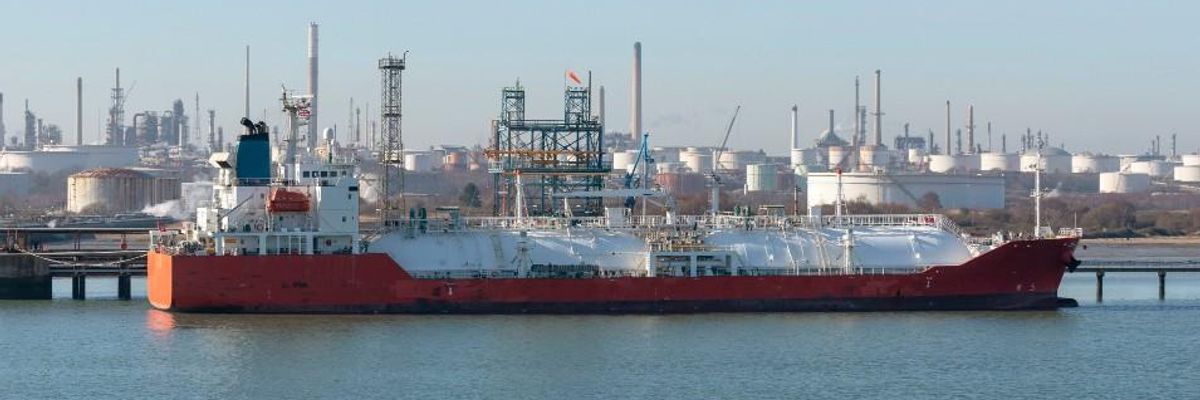
A fossil fuel ship is seen near the Port of Southampton in the United Kingdom. (Photo: Peter Titmuss/Education Images/Universal Images Group via Getty Images)
To donate by check, phone, or other method, see our More Ways to Give page.

A fossil fuel ship is seen near the Port of Southampton in the United Kingdom. (Photo: Peter Titmuss/Education Images/Universal Images Group via Getty Images)
A boom in U.S. liquefied natural gas exports driven by Russia's invasion of Ukraine could add a staggering 90 million tons or more of planet-heating greenhouse gases annually, a report published Thursday revealed.
"A dramatic increase in global dependence on LNG could be risky, from a climate perspective."
The Environmental Integrity Project (EIP) publication--entitled Playing With Fire: The Climate Impact of the Rapid Growth of LNG--notes that the United States went from exporting no liquefied natural gas in 2015 to becoming one of the world's leading LNG exporters by 2021.
Now, with the Russian invasion causing "unprecedented supply disruptions" and driving fuel prices to record levels in much of the world, the paper says the U.S. is soon expected to lead the world in LNG export capacity.
The report notes that this gas export boom "will have a significant environmental impact," as 25 LNG construction or expansion projects in the U.S., including four new terminals being built in Texas and Louisiana, "could emit more than 90 million tons of greenhouse gases per year."
"That's almost as much climate-warming pollution as 18 million passenger vehicles running for a year--more than from all the cars and trucks in Florida or New York state," the paper says.
These potential greenhouse gas impacts "would only come from operating the LNG terminals themselves," the report notes. "They do not include emissions from drilling and hydraulic fracturing, or the eventual burning of gas in homes and businesses. If these upstream and downstream contributions are accounted for, the true climate footprint of LNG would be several times higher."
Alexandra Shaykevich, research manager at EIP, said in a statement that "a dramatic increase in global dependence on LNG could be risky, from a climate perspective."
"Although there is pressure to hurry up approvals of these LNG projects," she added, "government regulators should be careful and thoughtful in considering their significant environmental impacts."
The EIP report was released the day after an explosion rocked amajor liquefied natural gas plant in Texas.
Related Content

The new analysis also follows a new Climate Action Tracker report detailing how, instead of heeding progressive calls to accelerate a global clean energy transition, policymakers are expanding fossil fuel production amid a worldwide "gold rush" in gas production, pipelines, and LNG facilities.
Donald Trump’s attacks on democracy, justice, and a free press are escalating — putting everything we stand for at risk. We believe a better world is possible, but we can’t get there without your support. Common Dreams stands apart. We answer only to you — our readers, activists, and changemakers — not to billionaires or corporations. Our independence allows us to cover the vital stories that others won’t, spotlighting movements for peace, equality, and human rights. Right now, our work faces unprecedented challenges. Misinformation is spreading, journalists are under attack, and financial pressures are mounting. As a reader-supported, nonprofit newsroom, your support is crucial to keep this journalism alive. Whatever you can give — $10, $25, or $100 — helps us stay strong and responsive when the world needs us most. Together, we’ll continue to build the independent, courageous journalism our movement relies on. Thank you for being part of this community. |
A boom in U.S. liquefied natural gas exports driven by Russia's invasion of Ukraine could add a staggering 90 million tons or more of planet-heating greenhouse gases annually, a report published Thursday revealed.
"A dramatic increase in global dependence on LNG could be risky, from a climate perspective."
The Environmental Integrity Project (EIP) publication--entitled Playing With Fire: The Climate Impact of the Rapid Growth of LNG--notes that the United States went from exporting no liquefied natural gas in 2015 to becoming one of the world's leading LNG exporters by 2021.
Now, with the Russian invasion causing "unprecedented supply disruptions" and driving fuel prices to record levels in much of the world, the paper says the U.S. is soon expected to lead the world in LNG export capacity.
The report notes that this gas export boom "will have a significant environmental impact," as 25 LNG construction or expansion projects in the U.S., including four new terminals being built in Texas and Louisiana, "could emit more than 90 million tons of greenhouse gases per year."
"That's almost as much climate-warming pollution as 18 million passenger vehicles running for a year--more than from all the cars and trucks in Florida or New York state," the paper says.
These potential greenhouse gas impacts "would only come from operating the LNG terminals themselves," the report notes. "They do not include emissions from drilling and hydraulic fracturing, or the eventual burning of gas in homes and businesses. If these upstream and downstream contributions are accounted for, the true climate footprint of LNG would be several times higher."
Alexandra Shaykevich, research manager at EIP, said in a statement that "a dramatic increase in global dependence on LNG could be risky, from a climate perspective."
"Although there is pressure to hurry up approvals of these LNG projects," she added, "government regulators should be careful and thoughtful in considering their significant environmental impacts."
The EIP report was released the day after an explosion rocked amajor liquefied natural gas plant in Texas.
Related Content

The new analysis also follows a new Climate Action Tracker report detailing how, instead of heeding progressive calls to accelerate a global clean energy transition, policymakers are expanding fossil fuel production amid a worldwide "gold rush" in gas production, pipelines, and LNG facilities.
A boom in U.S. liquefied natural gas exports driven by Russia's invasion of Ukraine could add a staggering 90 million tons or more of planet-heating greenhouse gases annually, a report published Thursday revealed.
"A dramatic increase in global dependence on LNG could be risky, from a climate perspective."
The Environmental Integrity Project (EIP) publication--entitled Playing With Fire: The Climate Impact of the Rapid Growth of LNG--notes that the United States went from exporting no liquefied natural gas in 2015 to becoming one of the world's leading LNG exporters by 2021.
Now, with the Russian invasion causing "unprecedented supply disruptions" and driving fuel prices to record levels in much of the world, the paper says the U.S. is soon expected to lead the world in LNG export capacity.
The report notes that this gas export boom "will have a significant environmental impact," as 25 LNG construction or expansion projects in the U.S., including four new terminals being built in Texas and Louisiana, "could emit more than 90 million tons of greenhouse gases per year."
"That's almost as much climate-warming pollution as 18 million passenger vehicles running for a year--more than from all the cars and trucks in Florida or New York state," the paper says.
These potential greenhouse gas impacts "would only come from operating the LNG terminals themselves," the report notes. "They do not include emissions from drilling and hydraulic fracturing, or the eventual burning of gas in homes and businesses. If these upstream and downstream contributions are accounted for, the true climate footprint of LNG would be several times higher."
Alexandra Shaykevich, research manager at EIP, said in a statement that "a dramatic increase in global dependence on LNG could be risky, from a climate perspective."
"Although there is pressure to hurry up approvals of these LNG projects," she added, "government regulators should be careful and thoughtful in considering their significant environmental impacts."
The EIP report was released the day after an explosion rocked amajor liquefied natural gas plant in Texas.
Related Content

The new analysis also follows a new Climate Action Tracker report detailing how, instead of heeding progressive calls to accelerate a global clean energy transition, policymakers are expanding fossil fuel production amid a worldwide "gold rush" in gas production, pipelines, and LNG facilities.